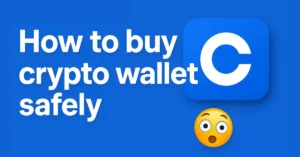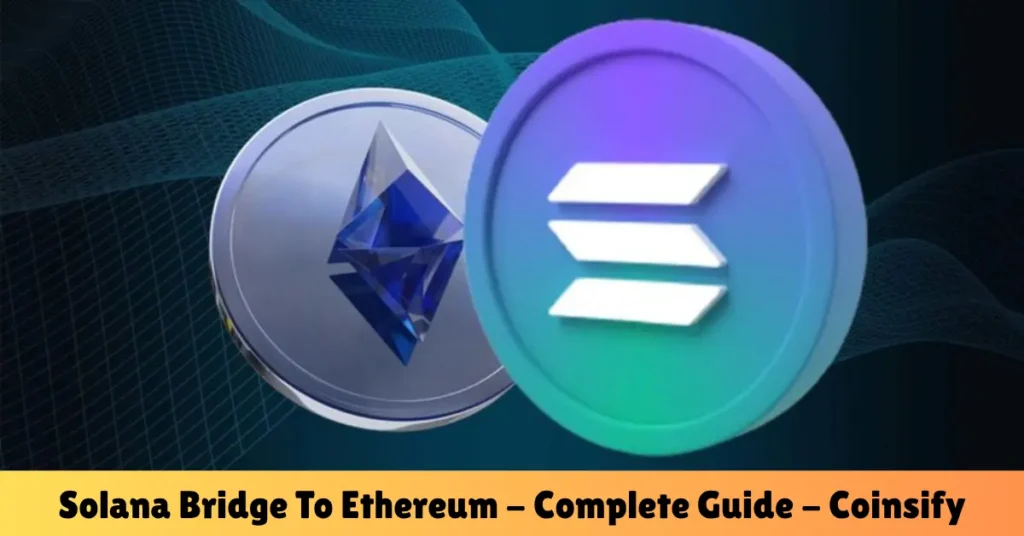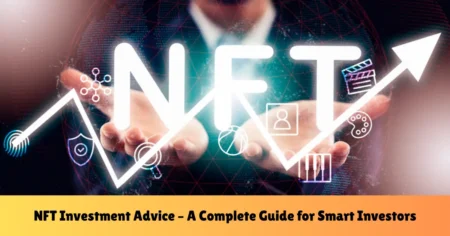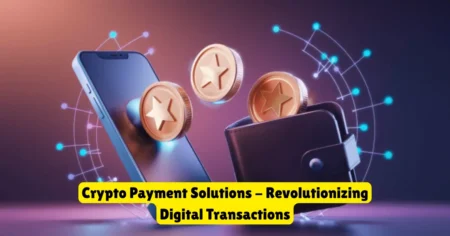Introduction
In the world of cryptocurrency, new technologies are being developed every day to help blockchains work better together. One of these technologies is called a blockchain bridge—a tool that lets you move digital assets like tokens and NFTs from one blockchain to another. This is especially useful when dealing with two popular blockchains: Solana and Ethereum.
Solana is known for its fast transactions and low fees, while Ethereum is famous for its smart contracts and large developer community. But since they are two separate systems, you can’t directly move assets between them without some help. That’s where a Solana Bridge to Ethereum comes in—it acts like a secure connection between the two.
If you’re new to this concept, don’t worry. In this blog, we’ll explain everything in simple terms. We’ll also share how sources like Coinsify help provide clear information on how these bridges work, what benefits they offer, and what to watch out for.
Let’s explore how the Solana-Ethereum bridge makes crypto more connected and flexible for users like you.
What is a Blockchain Bridge?
A blockchain bridge is a tool that allows different blockchains to connect and share information or assets with each other. Think of it like a digital highway that lets you move tokens, NFTs, or data from one blockchain (like Ethereum) to another (like Solana).
Since most blockchains are built separately, they don’t naturally “talk” to each other. That means you can’t normally use an Ethereum-based token on the Solana network—or vice versa. A bridge solves this problem by creating a safe and structured way to transfer assets between chains.
For example, if you want to send your Ethereum (ETH) to Solana, the bridge will lock your ETH on the Ethereum side and give you a wrapped version of ETH on the Solana side. This wrapped token can be used in Solana’s ecosystem just like a regular token. When you want to move it back, the process is reversed.
In short, a blockchain bridge helps make different blockchain networks more connected, flexible, and interoperable—which is an important step toward a more open and unified Web3 world.
Understanding Solana
Solana is a modern blockchain platform designed to offer fast, low-cost, and scalable transactions. It was created to solve some of the main problems that older blockchains like Ethereum face, such as slow transaction speeds and high fees.
One of Solana’s biggest strengths is its speed. It can process thousands of transactions per second, which makes it much faster than many other blockchains. At the same time, the transaction fees on Solana are very low, often costing just a small fraction of a cent. This makes it ideal for everyday users and developers who want to build and use decentralized apps (dApps) without worrying about high costs.
Another key feature of Solana is its unique technology. It uses a system called Proof of History (PoH) along with Proof of Stake (PoS) to keep the network secure and efficient. This combination helps Solana achieve high performance without sacrificing security or decentralization.
Solana is also home to a growing ecosystem of projects, including:
- DeFi (Decentralized Finance) apps
- NFT (Non-Fungible Token) marketplaces
- Gaming platforms
- Web3 tools and services
Thanks to its speed, low fees, and strong developer support, Solana is becoming one of the most popular blockchains in the crypto space—especially for people looking for faster and more affordable alternatives to Ethereum.
Understanding Ethereum
Ethereum is one of the most well-known and widely used blockchains in the world. It was launched in 2015 and introduced the concept of smart contracts—self-executing programs that run on the blockchain. This made it possible to create decentralized applications (dApps) that operate without needing a central authority.
Unlike Bitcoin, which is mainly used for digital payments, Ethereum is like a global computer. Developers can build all kinds of applications on it—such as DeFi platforms, NFT marketplaces, games, and more.
Here are some key features of Ethereum:
- Smart Contracts: These are automated programs that run exactly as written, with no downtime or interference.
- Strong Developer Community: Ethereum has the largest group of blockchain developers constantly improving the platform and building new projects.
- DeFi and NFTs: Most of the early growth in decentralized finance and NFTs happened on Ethereum, making it the go-to platform for innovation in Web3.
However, Ethereum also has some limitations:
- High Gas Fees: During busy times, users have to pay high fees to complete transactions.
- Scalability Issues: Ethereum can only handle a limited number of transactions per second, which can lead to slow speeds and congestion.
To solve these problems, Ethereum has been upgrading its network (like with Ethereum 2.0), and many users have started exploring faster and cheaper alternatives like Solana. Still, Ethereum remains a foundational layer in the blockchain world and continues to power thousands of popular crypto applications.
Solana Bridge to Ethereum: What Is It?

A Solana Bridge to Ethereum is a tool or system that lets users move their digital assets—such as tokens or NFTs—from the Solana blockchain to the Ethereum blockchain, or the other way around.
Since Solana and Ethereum are two separate blockchains, they don’t naturally “talk” to each other. Their systems work differently, which makes direct transfers between them impossible. That’s where a blockchain bridge comes in. It acts like a middleman or connector that allows assets to move between these two networks safely and efficiently.
Let’s say you have a token on Ethereum and want to use it in a decentralized app (dApp) on Solana. A Solana-Ethereum bridge will:
- Lock your token on the Ethereum blockchain.
- Create a wrapped version of that token on the Solana blockchain.
- Let you use that wrapped token in the Solana ecosystem as if it were native.
When you want to move it back, the bridge will burn (destroy) the wrapped version on Solana and unlock the original token on Ethereum.
In simple terms, this bridge makes Solana and Ethereum compatible by allowing users to shift their assets across blockchains. It brings together the speed and low cost of Solana with the rich features and apps on Ethereum—giving users more options, flexibility, and control over how they use their crypto.
How Does Solana Bridge to Ethereum Work?
The process of moving assets between Solana and Ethereum might sound technical, but it can be explained in simple steps. The main goal of a Solana-Ethereum bridge is to safely transfer tokens from one blockchain to another without losing their value or ownership.
Here’s a step-by-step breakdown of how it works:
Initiating the Transfer
You start by choosing a trusted bridge (such as Wormhole or Allbridge) and selecting the asset you want to move—from Solana to Ethereum or vice versa.
Locking the Original Token
When you send a token from, say, Solana to Ethereum, the bridge locks your token in a smart contract on the Solana side. This means the token is safely stored and cannot be used on Solana while it exists on Ethereum.
Creating a Wrapped Token
Once your original token is locked, the bridge creates a wrapped version of that token on the Ethereum network. For example, if you’re moving SOL to Ethereum, you’ll receive Wrapped SOL (wSOL) on Ethereum. This wrapped token has the same value as the original one.
Using the Wrapped Token
Now you can use the wrapped token on the new blockchain (Ethereum, in this case). It behaves just like the original token—it can be traded, used in DeFi apps, or held in a wallet.
Reversing the Process (Optional)
If you want to move your token back, the bridge will burn the wrapped token on Ethereum and unlock the original token on Solana, sending it back to your wallet.
Key Components That Make This Work:
- Smart Contracts: Automated programs that handle the locking, minting, burning, and releasing of tokens.
- Validators or Oracles: These are systems that verify and confirm that a transaction has happened on one chain before triggering action on the other.
- Wrapped Tokens: These are copies of the original tokens created to represent them on a different blockchain.
By using these steps, the Solana-Ethereum bridge helps users move their assets safely between two very different blockchains. It opens up a world of opportunities where you can benefit from the best features of both networks—like Solana’s speed and Ethereum’s DeFi tools.
Use Cases and Benefits
Using a Solana Bridge to Ethereum opens up many exciting opportunities in the crypto space. Whether you’re a regular user, trader, or developer, this bridge brings flexibility and access to features across both blockchains. Here are some of the most common use cases and key benefits:
Cross-Chain DeFi (Decentralized Finance)
Users can move tokens between Ethereum and Solana to take advantage of better interest rates, farming opportunities, or lower transaction fees. For example, you might move assets to Solana for cheaper trades or bring them back to Ethereum for specific DeFi protocols.
NFT Interoperability
NFT holders can bridge their assets between chains to list or trade them on different marketplaces. You might mint an NFT on Solana and then bridge it to Ethereum to sell on a larger platform like OpenSea.
Lower Fees and Faster Transactions
Ethereum is powerful, but it can be expensive and slow during peak times. Bridging assets to Solana gives users access to faster transactions and very low fees, making it more practical for frequent trades or microtransactions.
Improved Liquidity Access
Bridging helps users tap into liquidity pools on both blockchains. This allows for better trading options, higher yields, and a wider choice of tokens.
Greater Flexibility for Developers
Developers can build apps that work across both ecosystems, allowing them to reach more users and combine the best features of each chain. This is especially helpful for multi-chain DeFi platforms and games.
Expanding User Choice
The bridge gives users more freedom to choose the platform that best fits their needs—whether it’s Ethereum for its mature ecosystem or Solana for its speed and affordability.
In summary, the Solana-Ethereum bridge helps users and developers move freely between two powerful blockchain worlds. It creates more possibilities for how you use your crypto, without being limited to a single network.
Risks and Limitations
While the Solana Bridge to Ethereum offers many benefits, it’s also important to understand the risks and limitations that come with using it. Like any technology in the crypto space, blockchain bridges aren’t perfect—and being aware of the downsides can help you stay safe and make better decisions.
Smart Contract Vulnerabilities
Bridges work using smart contracts, and if there’s a bug or flaw in the code, it can be exploited by hackers. Several bridges in the past have been targeted, resulting in the loss of millions of dollars. That’s why it’s important to use well-audited and trusted bridges only.
Centralization Risks
Some bridges rely on centralized systems or a small group of validators to approve transactions. This goes against the decentralized nature of blockchain and could lead to trust issues or control problems.
High Gas Fees on Ethereum
Even though Solana is low-cost, moving assets to or from Ethereum can still be expensive due to Ethereum’s gas fees. This can make small transfers less practical or cost-effective.
Wrapped Token Risks
When you bridge assets, you often receive a wrapped version of your original token. These wrapped tokens depend on the bridge’s security and stability. If the bridge fails, your wrapped tokens may lose their value or become unusable.
Network Congestion
If either Ethereum or Solana is overloaded, the bridge might slow down or transactions could get stuck. Delays and technical issues are still common, especially during times of high traffic.
User Errors
Sending assets to the wrong address, selecting the wrong chain, or misunderstanding bridge instructions can lead to permanent loss of funds. Always double-check each step when using a bridge.
Final Thoughts
Blockchain bridges like the one between Solana and Ethereum bring exciting possibilities, but they also come with real risks. Before using any bridge, make sure to do your research, use trusted platforms, and never move large amounts unless you’re confident in the process.
Popular Solana-Ethereum Bridges

There are several well-known bridges that help users transfer assets between Solana and Ethereum. Each of them comes with different features, levels of security, and user experiences. Here are some of the most popular and widely used ones:
Wormhole
Wormhole is one of the most trusted and widely used bridges between Solana and Ethereum. It supports the transfer of various assets, including tokens and NFTs.
Key Features:
- Fast and low-cost transfers
- Supports multiple chains beyond just Ethereum and Solana
- Backed by strong developer support
Allbridge
Allbridge is a simple and user-friendly bridge that allows cross-chain transfers between Solana, Ethereum, and many other blockchains.
Key Features:
- Supports a wide range of tokens
- Focuses on speed and flexibility
- Good for both developers and everyday users
Portal Bridge (Built on Wormhole)
Portal Bridge is the official interface for using the Wormhole protocol. It’s often used by beginners due to its clean design and step-by-step process.
Key Features:
- Secure and audited
- Simple UI for transferring tokens between Ethereum and Solana
- Integrates easily with wallets like MetaMask and Phantom
Celer cBridge
Celer cBridge is a multi-chain bridge that also includes Solana and Ethereum support. It’s known for quick transfers and wide token support.
Key Features:
- Fast transactions
- Good for both users and developers
- Strong reputation in the bridging space
How to Choose the Right Bridge?
When selecting a Solana-Ethereum bridge, consider the following:
- Security (Is the bridge audited and well-tested?)
- Supported Assets (Does it support the tokens you want to move?)
- Ease of Use (Is the user interface beginner-friendly?)
- Fees and Speed (How fast is it, and what does it cost to use?)
Using a trusted bridge can make a big difference in the safety and smoothness of your cross-chain transfers. Always research and use official links to avoid scams.
Frequently Asked Questions (FAQs)
What is a Solana-Ethereum bridge?
A Solana-Ethereum bridge is a tool that lets you move tokens or NFTs between the Solana and Ethereum blockchains. It helps users access apps and services across both networks without losing their assets.
Why would I use a bridge instead of just staying on one blockchain?
Each blockchain has its own benefits. For example, Solana is fast and low-cost, while Ethereum has a rich DeFi and NFT ecosystem. A bridge lets you enjoy the best of both worlds.
Are Solana-Ethereum bridges safe to use?
Bridges are generally safe if you use trusted ones like Wormhole or Allbridge. But like any tech, they’re not risk-free. There have been past hacks, so always do your research and avoid sending large amounts in one go.
Do I need different wallets for Solana and Ethereum?
Yes. Ethereum uses wallets like MetaMask, while Solana uses wallets like Phantom or Solflare. You’ll need both if you’re bridging assets between the two.
What is a wrapped token?
When you move a token from one blockchain to another, a “wrapped” version is created. For example, if you send SOL to Ethereum, you’ll get Wrapped SOL (wSOL). It has the same value but works on a different chain.
Are there fees when using a bridge?
Yes. You may pay network fees (gas) on both chains. Solana’s fees are very low, but Ethereum’s fees can be high, especially during busy times.
Can I move NFTs across chains using a bridge?
Yes, some bridges support NFT transfers. However, not all NFTs can be bridged easily. Always check if your specific NFT is supported by the bridge you’re using.
What should I do if my tokens don’t arrive?
First, don’t panic. Most bridges have a status tracker or support page. Double-check the transaction details, and contact the bridge’s support if needed. Always make sure you’re using the official website to avoid scams.
Conclusion
The Solana-Ethereum bridge is a powerful tool that connects two of the biggest blockchain networks, giving users more freedom and flexibility. Whether you’re looking to save on fees, access new apps, or explore different crypto ecosystems, using a bridge can make it easier to move your assets where you need them.
Just remember to use trusted platforms, stay cautious, and double-check every step. With the right approach, bridging can open up a world of new opportunities in the crypto space.
Bonus Points
Use Reputable Wallets
- Always use well-known and secure wallets like MetaMask (for Ethereum) and Phantom (for Solana) when bridging assets.
Double-Check Bridge URLs
- Only use official websites for bridges. Fake sites can steal your funds. Bookmark trusted platforms to avoid phishing scams.
Start Small
- If you’re using a bridge for the first time, start with a small amount to test the process before moving larger funds.
Check Network Status
- Sometimes, network congestion can delay transactions. Check the status pages of the bridge and the networks before making a transfer.
Stay Updated
- Follow the official Twitter or Discord channels of the bridge you use. This helps you stay informed about any updates, bugs, or security issues.
Consider Timing
- Bridging from Ethereum can be expensive during peak hours due to high gas fees. Try to make your transactions during low-traffic times to save money.
Learn Before You Bridge
- Read the bridge’s user guides or help sections. Understanding the process fully reduces the chances of making costly mistakes.
Also read
- What is a Crypto Wallet and How Does It Work? – Coinsify
- 10 Crypto Terms Every Beginner Must Know – Coinsify
- What is Blockchain Technology – Complete Guide – Coinsify
- How to Buy Crypto Safely in 2025 – Complete Guide – Coinsify
- Bitcoin vs Ethereum: Key Differences Explained – Complete Guide
- Ultimate Blockchain Glossary: Learn Blockchain Terms Easily
- How to Buy Bitcoin Safely (Complete Beginner’s Guide)
- Top 10 Crypto Wallets for Beginners (2025 Edition)
- What is Cryptocurrency? A Beginner-Friendly Guide (2025)






